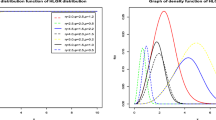Abstract
The goal of many earthquake engineering analyses is to ensure that a structure can withstand a given level of ground shaking while maintaining a desired level of performance. But there is a great deal of uncertainty about the numerous factors that impact the level of ground shaking. probabilistic seismic hazard analyses (PSHA) aim to quantify these uncertainties and combine them to produce an explicit description of the distribution of future shaking that may occur at a site. Among others, the distribution of the magnitudes is required by PSHA. This paper presents a new approach to estimate both the tail distribution of earthquake magnitudes and the tail distribution of the maximum earthquake magnitude over a year. This approach uses extreme value models based on Poisson process. The main innovations consist of combining the use of the generalized Pareto distribution (GPD) to model the tail distribution of earthquake magnitudes and the exact relation leading to the tail distribution of the annual maximum earthquake magnitude. We also propose a statistical inference that takes into account the growing incompleteness of the data in earlier times, which enables us to use as much available data as we can. This paper also provides a sensitivity analysis, which quantifies the robustness of the results with respect to two types of uncertainty: the statistical uncertainty due to the limited number of data used for the statistical inference and the uncertainty related to the determination of the complete observation periods of time by the seismologists. We detail validation tests to check the main assumptions underlying the probabilistic model: the Poisson occurrences of earthquakes and the GPD behavior of the tail distribution. The methodology is applied to an area located in the south of France, which provides estimates of some extreme quantiles of the annual maximum earthquake magnitude.














Similar content being viewed by others
References
Beirlant, J., et al. (2005). Statistics of extremes, theory and application. Wiley Series in Probability and Statistics, 169, 149. (ISBN 978-0-471-97647-9).
Beirlant, J., Kijko, A., et al. (2018). Estimating the maximum possible earthquake magnitude using extreme value methodology: the Groningen case. Natural Hazards, 169, 1–23. https://doi.org/10.1007/s11069-017-3162-2.
Bird, P., & Kagan, Y. Y. (2004). Plate tectonic analysis of shallow seismicity: Apparent boundary width, beta, corner magnitude, coupled lithosphere thisckness, and coupling in seven tectonic settings. Bulletin of the Seismological Society of America, 94(6), 2380–2399.
Blanter, E. M., Shnirman, M. G., & Le Mouel, J. L. (1999). Temporal variation in a hierarchical model of dynamical self-organized criticality. Springer, Internal Geopysics-Physics of the Earth and Planetary Interiors, 111, 314–327.
Burton, P. W., & Makropoulos, C. (1985). Seismic risk of circum-Pacific earthquakes: II. Extreme values using Gumbel’s third distribution and the relationship with the strain energy release. SPAGEOPH, 123, 849–869.
Campbell, K. W. (1982). Bayesian ananlysis of extreme earthquake occurrences. Part I. Probabilistic hazard model. Bulletin of Seismological Society of American, 72(5), 1689–1705.
Cosentino, P., Ficara, V., & Luzio, D. (1977). Truncated exponential frequency-magnitude relationship in earthquakes statistics. Bulletin of Seismological Society of American, 67, 1615–1623.
“Catalogues de mesures de séismes déclusterisés de France”, référence FCAT\_17.
Gutenberg, B., & Richter, C. F. (1936). Magnitude and energy of earthquakes. Science, 83, 183–185.
Gutenberg, B., & Richter, C. F. (1945). Earthquakes magnitude, intensity, energy and acceleration. Bulletin of Seismological Society of American, 46(3), 105–145.
Haarala, M., & Orosco, L. (2016). Analysis of Gutenberg-Richter \(b\)-value and \(m_{{\rm max}}\). Part I: Exact solution of Kijko–Sellevoll estimator \(m_{{\rm max}}\). Cuadernos de Ingenieria. Nueva Serie. Publicationes Academicas Fac. Ingenieria, Universidad Catolica de Salta, 9, 51–78.
Haarala, M., & Orosco, L. (2016). Analysis of Gutenberg–Richter \(b\)-value and \(m_{{\rm max}}\). Part II: Estimators for \(b\)-value and exact variance. Cuadernos de Ingenieria. Nueva Serie. Publicationes Academicas Fac. Ingenieria, Universidad Catolica de Salta, 9, 79–106.
Keller, M., Pasanisi, A., Marcilhac, M., Yalamas, Th, & Secanell, Senfaute G. (2014). A bayesian methodology apllied to the estimation of earthquake recurrence parameters for seismic hazard assessment. Quality and Reliability Engineering International, 30, 921–933. https://doi.org/10.1002/qre.1735.
Kijko, A., & Sellevoll, M. A. (1989). Estimation of earthquakes hazard parameters from incomplete data files. Part 1. Utilization of extreme and incomplete catalogs with different threshold magnitudes. Bulletin of Seismological Society of American, 79(3), 644–654.
Page, R. (1968). Aftershock and microaftershocks. Bulletin of Seismological Society of American, 58, 1131–1168.
Pillet, R. (1997). Mise en évidence du comportement multifractal de la distribution fréquence-magnitude d’un échantillon sismique (loi de Gutenberg–Richter). Internal Geopysics-Physics of the Earth and Planetary Interiors, 324, 805–810.
Pisarenko, V. F., Sornette, A., Sornette, D., & Rodkin M. V. (2008). Characterization of the Tail of the Distribution of Earthquake Magnitudes by combining the GEV and GPD description of Extreme Value Theory.
Pisarenko, V. F., & Sornette, D. (2003). Characterization of the frequency of extreme earthquakes events by the Generalized Pareto distribution. Pure and Applied Geophysics, 160, 2343–2364.
Pisarenko, V. F., & Sornette, D. (2004). Statistical detection and characterization of a deviation from the Gutenberg–Richter distribution above magnitude 8. Pure and Applied Geophysics, 161, 839–864.
Pisarenko, V. F., Sornette, A., Sornette, D., & Rodkin, M. V. (2008). New approach to the characterization of Mmax and of the tail of the distribution of earthquake magnitudes. Pure and Applied Geophysics, 165, 1–42.
Streit R. L. (2010). Poisson point processes - imagining, tracking and censing. WSpringer, isbn 978-1-4419-6922-4.
Turcotte, D. L. (1999). Seismicity and self-organized criticality. Physics of the Earth and Planetary Interiors, 111, 275–293.
Weichert, D. H. (1980). Estimation of the earthquake recurrence parameters for unequal observation periods for different magnitudes. Bulletin of Seismological Society of American, 70(4), 1337–1346.
Author information
Authors and Affiliations
Corresponding author
Rights and permissions
About this article
Cite this article
Dutfoy, A. Estimation of Tail Distribution of the Annual Maximum Earthquake Magnitude Using Extreme Value Theory. Pure Appl. Geophys. 176, 527–540 (2019). https://doi.org/10.1007/s00024-018-2029-0
Received:
Revised:
Accepted:
Published:
Issue Date:
DOI: https://doi.org/10.1007/s00024-018-2029-0




